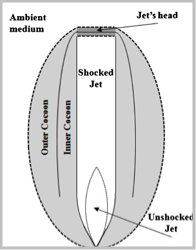Relativistic jets and the Collapsar model

The propagation of a relativistic jet in an external medium is a key process in high energy astrophysics. We constructed a self consistent analytic model of that propagation, that accounts for the collimation shocks that may form at the base of such jets. We consider the implications of our results to the Collapsar model for gamma-ray bursts (GRBs). A key property of the jet-envelope interaction is that while the jet is drilling through the star its energy is dissipated. As a result the duration of the observed GRBs reflects only the time that the central engine was launching the jet after the latter broke out of the stellar envelope. This simple property results in a predicted imprint on the duration distribution of GRBs, with far reaching implications. We find this imprint in the observed distribution, providing the first direct observational support to the Collapsar model. We also use it to infer the typical jet break time and on the number of “choked” jets (i.e, jets that fail to break out of the envelope). Finally, we show that low-luminosity GRBs are unlikely to be produced by jets that penetrate their progenitor stars, like regular GRBs. This result fits with our finding that low-luminosity GRBs can be well explained by relativistic shock breakouts (see next topic).

Jet-Cocoon structure (Bromberg et al., 2011)



